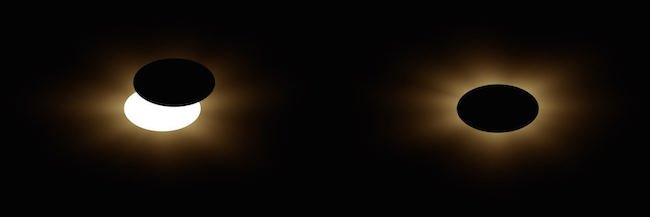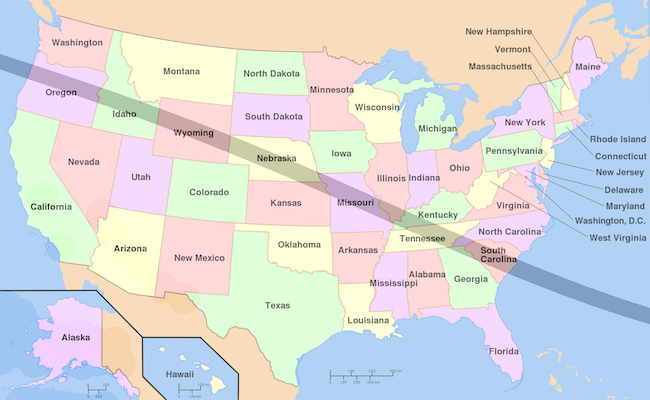Total Solar Eclipse 2017

Do you know what a total solar eclipse is? Where do you live? If you live in the United States you may have the opportunity to see one August 21st, 2017. Read on to find out more about the upcoming and rare total solar eclipse.
The United States will see a total solar eclipse in 2017. Quite rare, a total solar eclipse allows a bare-eye view of the totality. With 14 total solar eclipses occurring in the last 100 years, this one differs, as it expands across the central part of the United States.
Cactus26, CC BY-SA 3.0, via Wikimedia Commons
Mark Your Calendar For the Eclipse
The 70-mile (113-kilometer) path will span from Oregon to South Carolina. For 93 minutes that thin path in the United States will darken.
Quick Facts
- Be on the center line. This probably isn’t a revelation, but the Moon’s shadow is round. If it were square, it wouldn’t matter where you viewed totality. People across its width would experience the same duration of darkness. The shadow is round, however, so the longest eclipse occurs at its center line because that’s where you’ll experience the Moon’s shadow’s full width.
- The center line crosses through 12 states. After a great west-to-east path across Oregon, the center line takes roughly nine minutes to cross a wide swath of Idaho, entering the western part of the state just before 11:25 a.m. MDT and leaving just before 11:37 a.m. MDT. Next up is Wyoming, where the umbral center line dwells until just past 11:49 a.m. MDT. From 11:47 a.m. MDT until 1:07 CDT (note the time zone change!), the dark part of the Moon’s shadow lies in Nebraska. The center line hits the very northeastern part of Kansas at 1:04 p.m. CDT and enters Missouri a scant two minutes later. At 1:19, the shadow’s midpoint crosses the Mississippi River, which at that location is the state border with Illinois. The center line leaves Illinois at its Ohio River border with Kentucky just past 1:24 p.m. CDT. Totality for that state starts there two minutes earlier and lasts until nearly 1:29 p.m. CDT. The center line crosses the border into Tennessee around 1:26 p.m. CDT. Then, just past the midpoint of that state, the time zone changes to Eastern. North Carolina has the midpoint of the eclipse from 2:34 p.m. EDT until just past 2:38 p.m. EDT. The very northeastern tip of Georgia encounters the center line from just past 2:35 p.m. EDT until not quite 2:39 p.m. EDT. Finally, it’s South Carolina’s turn. The last of the states the center line crosses sees its duration from 2:36 p.m. EDT to 2:39 p.m. EDT. (Astronomy.com 2107)
- Nashville, TN will have the best view and longest duration.
- You may look at the eclipse during totality without eye protection. Never look at the sun directly otherwise.
- You will not need a telescope. You can see the Corona surrounding the Moon’s black disk with your eyes or a set of low powered binoculars.
- During totality, take just a few seconds to tear your eyes away from the sky and scan the horizon. Sunset colors will cover all around due to the effect of the sunrise and sunset happening. (Astronomy.com 2017)
How to Help Science
Millions of people, from students to rocket scientists, will offer scientists a wealth of new information regarding how the Sun works. The National Science Foundation reports that they believe millions of people will participate in the event collecting images and data. A project names Eclipse MegaMovie, a joint venture between Google and University of California, Berkeley, plans to assemble images taken by students and other amateur observers along the eclipse path. They plan on using the information to create educational materials.
During the 93-minute eclipse, another group named the Citizens Continental-America Telescopic Eclipse (CATE) Experiment will gather data. The volunteers from national labs, high schools, and colleges will use identical telescopes and digital cameras to capture high quality images. Experts from government agencies and universities also have plans for their own data collection.
US Government and NASA
Government aircraft will be dispatched to follow the eclipse and take infrared measurements to determine the solar corona’s magnetism and thermal structure.
Meanwhile, NASA plans to use a camera aboard its Deep Space Climate Observatory (DSCOVR), a satellite that sits in a distant orbit about 900,000 miles (1.4 million kilometers away), to capture the view of light leaving the Earth.
Two other satellite tools aboard the Terra and Aqua satellites, launched in 1999 and 2002, respectively, “will provide observations of atmospheric and surface conditions at times before and after the eclipse,” said NASA.
This data should help scientists better calculate how much solar energy hits the top of our atmosphere, how much is reflected back to space and how much thermal energy Earth sends off into space.
Download the Globe App
In order to participate in data collection, first download the GLOBE Observer app, and then register to become a citizen scientist. The app will instruct you on how to make the observations. Second, you will need to obtain a thermometer to measure air temperature.
Observations will be recorded on an interactive map.
To join in the fun, download the GLOBE Observer app observer.globe.gov/about/get-the-app. After you log in, the app explains how to make eclipse observations.
